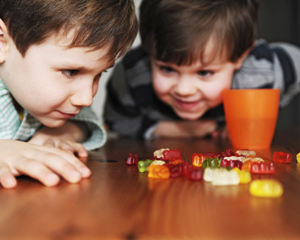Mintz has argued that a primary reason sugar has escaped social disapproval is that, whatever conspicuous behavioural changes may occur when infants consume sugar, it did not cause the kind of "flushing, staggering, dizziness, euphoria, changes in the pitch of the voice, slurring of speech, visibly intensified physical activity or any of the other cues associated with the ingestion" of other drugs. Sugar appears to cause pleasure with a price that is difficult to discern immediately and paid in full only years or decades later. With no visible, directly noticeable consequences, as Mintz says, questions of "long-term nutritive or medical consequences went unasked and unanswered". Most of us today will never know if we suffer even subtle withdrawal symptoms from sugar, because we'll never go long enough without it to find out.
明茨認(rèn)為,糖沒有受到社會(huì)反對的一個(gè)主要原因是,無論嬰兒攝入糖后可能會(huì)發(fā)生什么明顯的行為變化,它都不會(huì)導(dǎo)致“臉紅、蹣跚、頭暈、興奮、音調(diào)變化、口齒不清、明顯強(qiáng)化的身體活動(dòng)或任何其他與攝入其他藥物有關(guān)的跡象。糖似乎能帶來愉悅感,但其代價(jià)很難立即看出,而且要等到幾年或幾十年后才能完全付出。正如明茨所說,由于沒有明顯的、直接明顯的后果,關(guān)于“長期營養(yǎng)或醫(yī)療后果”的問題沒有得到解答。今天,我們中的大多數(shù)人永遠(yuǎn)都不會(huì)知道我們是否遭受了對糖的輕微戒斷癥狀,因?yàn)槲覀冇肋h(yuǎn)不會(huì)長時(shí)間不吃糖來發(fā)現(xiàn)這一點(diǎn)。

Sugar historians consider the drug comparison to be fitting in part because sugar is one of a handful of "drug foods", to use Mintz's term, that came out of the tropics, and on which European empires were built from the 16th century onward – the others being tea, coffee, chocolate, rum and tobacco.
糖歷史學(xué)家認(rèn)為用糖來比作藥物是合適的,部分原因是(用明茨的話來說)糖是少數(shù)幾種產(chǎn)自熱帶的“藥物食品”之一,從16世紀(jì)開始,歐洲帝國就在此基礎(chǔ)上建立起來,另外還有茶、咖啡、巧克力、朗姆酒和煙草。
Its history is intimately linked to that of these other drugs. Rum is distilled, of course, from sugar cane. In the 17th century, once sugar was added as a sweetener to tea, coffee and chocolate, and prices allowed it, the consumption of these substances in Europe exploded. Sugar was used to sweeten spirits and wine in Europe as early as the 14th century; even cannabis preparations in India and opium-based wines and syrups contained sugar.
糖的歷史與其他藥物的歷史密切相關(guān)。朗姆酒就是用甘蔗蒸餾而成的。在17世紀(jì),一旦糖被作為甜味劑添加到茶、咖啡和巧克力中,并且價(jià)格允許,這些物質(zhì)的消費(fèi)在歐洲就會(huì)暴增。早在14世紀(jì)的歐洲,糖就被用來給烈酒和葡萄酒添加甜味。甚至印度的大麻制劑和以鴉片為原料的葡萄酒和糖漿中也含有糖。
As for tobacco, sugar was, and still is, a critical ingredient in the American blended-tobacco cigarette, the first of which was Camel. It's this "marriage of tobacco and sugar", as a sugar-industry report described it in 1950, that makes for the "mild" experience of smoking cigarettes as compared with cigars and, perhaps more important, makes it possible for most of us to inhale cigarette smoke and draw it deep into our lungs.
至于煙草,糖過去是,現(xiàn)在仍然是美國混合煙草香煙的關(guān)鍵成分,最早的混合煙草是駱駝香煙。這就是“煙草和糖的聯(lián)姻”,正如1950年一份糖業(yè)報(bào)告中描述的那樣,與雪茄相比,它能使吸煙的體驗(yàn)更加的“溫和”,也許更重要的是,它使得我們大多數(shù)人有可能吸入香煙煙霧并將它深深地吸進(jìn)肺里。











